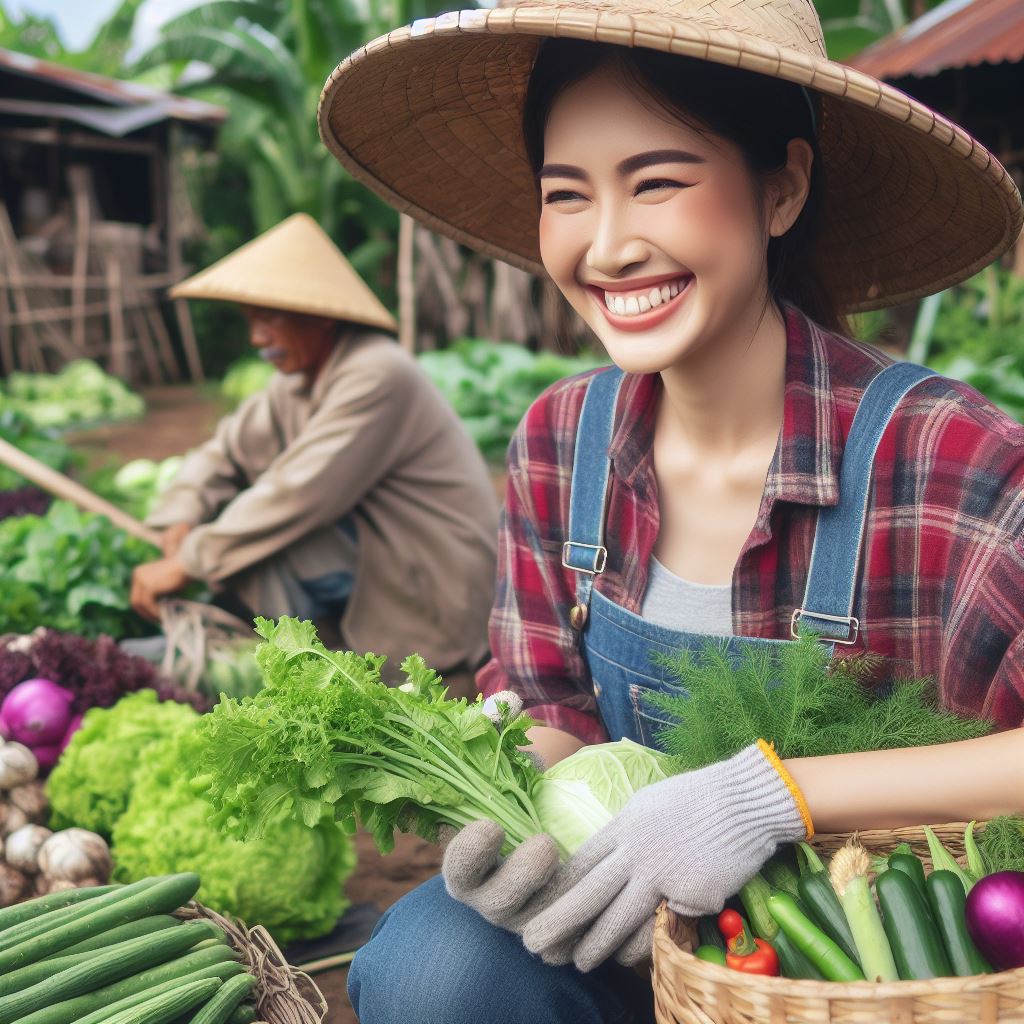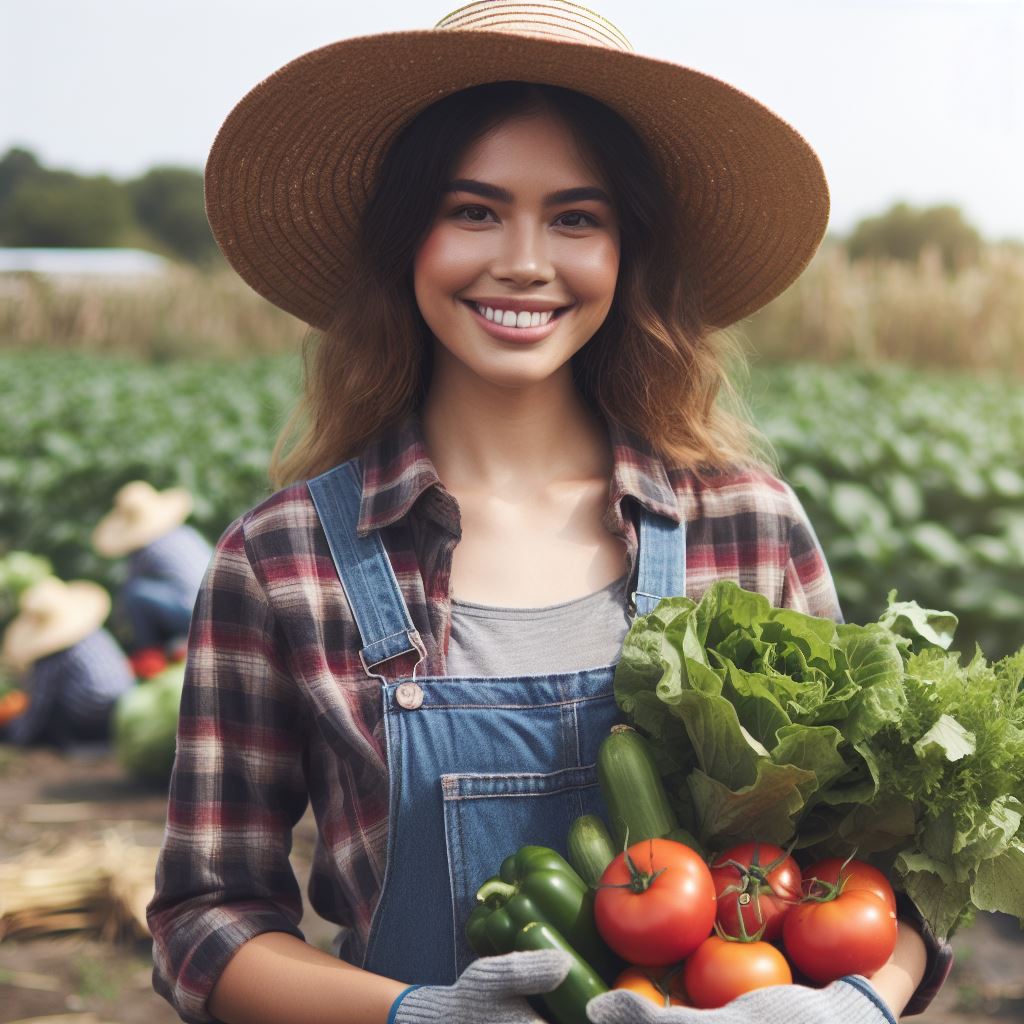Introduction
The Farm-to-Fork concept emphasizes the direct connection between farmers and consumers, promoting locally sourced and organic food. Jane’s organic farming practices align perfectly with this movement.
This blog post will delve into Jane’s practices and their impact on the Farm-to-Fork movement.
Jane’s farm is a prime example of Farm-to-Fork, as she grows her produce using strictly organic methods. She abstains from using synthetic pesticides, fertilizers, and genetically modified organisms.
Instead, she employs sustainable practices like crop rotation and natural composting.
To ensure the health of her soil, Jane regularly tests it for nutrient levels and adjusts her farming techniques accordingly. She maintains a diverse crop selection, including a variety of fruits, vegetables, and herbs.
Jane also practices intercropping, which involves growing different plants together to maximize space and discourage pests.
Moreover, Jane prioritizes animal welfare on her farm.
She keeps a small number of free-range chickens to provide organic eggs and natural pest control. In return, she ensures the chickens have ample space to roam and live a stress-free life.
Jane’s commitment to organic practices greatly contributes to the Farm-to-Fork movement. By avoiding the use of harmful chemicals, her produce is healthier and safer for consumers.
Additionally, her environmentally friendly farming techniques promote biodiversity and soil conservation.
Jane actively participates in local farmers’ markets, where she can directly connect with consumers.
Through these interactions, she educates people about the benefits of organic farming and encourages them to support the Farm-to-Fork movement.
In fact, Jane’s organic farming practices exemplify the ideals of the Farm-to-Fork movement.
Her dedication to sustainable, chemical-free practices not only benefits the health of consumers but also preserves the environment and supports local communities.
Jane’s Organic Farm
Jane’s organic farm, located in the picturesque countryside of Green Valley, is a haven for sustainable agriculture.
Transform Your Agribusiness
Unlock your farm's potential with expert advice tailored to your needs. Get actionable steps that drive real results.
Get StartedWith rolling hills, fertile soil, and a commitment to organic practices, Jane’s farm stands apart from conventional farms.
After years of conventional farming, Jane made a brave decision to transition to organic farming.
Inspired by a deep-rooted connection to nature and a desire to protect the environment, she embarked on this challenging but rewarding journey.
The organic certification process Jane went through was rigorous and comprehensive.
She had to meet the stringent standards set by the Organic Certification Board, ensuring that her farm adhered to the organic farming principles.
Jane’s commitment to sustainable agriculture goes beyond just obtaining certification. She passionately practices eco-friendly techniques that nurture the land and preserve its natural resources.
Brief Background on Jane’s Farm and Its Location
Jane’s farm is nestled in the heart of Green Valley, a small town known for its rich agricultural heritage. The farm spans over 100 acres of fertile land, blessed with abundant sunshine and clean air.
When Jane inherited the farm from her parents, it was a conventional farm heavily reliant on chemical fertilizers and pesticides.
However, Jane recognized the detrimental impact these practices had on the ecosystem and the health of her family and community.
Jane’s Decision to Transition to Organic Farming
Driven by her commitment to environmental stewardship, Jane decided to transition from conventional farming to organic farming.
She understood that by eliminating synthetic chemicals, her farm could become a sustainable and healthy haven.
Though the transition was not easy, Jane persevered and embraced the challenges along the way.
She had to relearn farming techniques, adopt organic pest management strategies, and enhance soil fertility through natural means.
Organic Certification Process Jane Went Through
Obtaining organic certification for her farm was a vital step for Jane.
She meticulously followed the certification process, which included submitting detailed records of her farming practices, soil and water samples, and undergoing regular inspections.
The Organic Certification Board scrutinized every aspect of her farm, ensuring compliance with strict standards.
It was a transparent and demanding process that ultimately validated Jane’s commitment to providing organic produce to her community.
Jane’s Commitment to Sustainable Agriculture
Jane firmly believes in the principles of sustainable agriculture. She employs practices like crop rotation, natural composting, and companion planting to maintain soil fertility and prevent pests and diseases.
In addition to these practices, Jane uses drip irrigation systems and rainwater harvesting techniques to conserve water resources.
She also actively promotes biodiversity on her farm by creating habitats for beneficial insects and using natural pest control methods.
Jane’s organic farm serves as a shining example of sustainable and ethical farming practices.
Through her dedication and passion, she not only produces high-quality organic produce but also contributes to the conservation and restoration of our planet.
Read: Meet Your Local Farmer: John Doe’s Story
Organic Crop Rotation
Importance of crop rotation in organic farming
Crop rotation is one of Jane’s key organic practices. She understands the significance of maintaining soil health and how it directly affects her farm’s productivity.
Showcase Your Farming Business
Publish your professional farming services profile on our blog for a one-time fee of $200 and reach a dedicated audience of farmers and agribusiness owners.
Publish Your ProfileBy rotating crops, she ensures that the soil retains its fertility and structure.
Specific crop rotation practices Jane follows
One of the major advantages of crop rotation in organic farming is its ability to improve and maintain soil fertility. Jane follows a four-year crop rotation plan, which involves dividing her farm into four sections.
Each section is assigned a particular crop for a year before rotating to the next section.
Examples of crops grown on Jane’s farm and their benefits to the soil
The crops grown on Jane’s farm are carefully selected to benefit the soil’s nutrient content and structure. In the first year, she plants nitrogen-fixing legumes such as clover and peas.
These legumes have a unique ability to extract nitrogen from the air and fix it into the soil, thus enriching it with this essential nutrient. This process increases soil fertility, providing a nutrient source for subsequent crops.
The second year involves planting deep-rooted crops like carrots and radishes. These crops help break up compacted soil and improve its structure, allowing better water infiltration and root development.
They also scavenge nutrients from deeper soil layers, preventing nutrient leaching and making them available to future crops.
During the third year, Jane focuses on growing leafy greens such as lettuce and kale.
These crops have shallow roots and help suppress weed growth by forming a dense canopy, preventing sunlight from reaching weed seedlings.
Finally, in the fourth year, Jane plants cover crops like oats and rye. These cover crops protect the soil from erosion, maintain its moisture content, and prevent weed growth during the fallow period.
How crop rotation helps in reducing pests and diseases without chemical intervention
Crop rotation also plays a crucial role in pest and disease management on Jane’s farm. By alternating crops, she effectively breaks the life cycles of pests and diseases that are specific to certain crops.
Each crop has its unique set of pests and diseases, and by interrupting their environment, Jane reduces the prevalence of these issues.
For example, pests that feed on one type of crop may not survive or reproduce on a different crop. By changing crops each year, Jane disrupts the pest’s food source, making it difficult for them to establish and multiply.
This natural pest control method reduces Jane’s reliance on chemical interventions, making her farming practices more sustainable and environmentally friendly.
Crop rotation is an essential practice in organic farming due to its numerous benefits.
Jane’s commitment to implementing a well-designed crop rotation plan contributes to the overall success of her farm, demonstrating the impact of organic practices on both environmental and agricultural sustainability.
Read: Growing Local: Bob’s Community Impact
Soil Health and Organic Amendments
Jane’s approach to building healthy soil
Jane understands the importance of building healthy soil for her organic farming practices.
Organic amendments used by Jane
Organic amendments, such as compost and cover crops, play a crucial role in Jane’s approach. Compost, a mixture of decomposed organic matter, enriches the soil with essential nutrients.
Cover crops, like legumes and grasses, are planted to protect and improve the soil during the off-season.
Benefits of organic amendments to soil fertility and structure
- The use of organic amendments benefits soil fertility by increasing microbial activity and promoting nutrient cycling.
- These amendments also help to improve the overall structure and texture of the soil, allowing for better water retention.
- A well-structured soil, thanks to organic amendments, creates an ideal environment for plant roots to grow and access nutrients.
How healthy soil contributes to the nutritional quality of the farm-to-fork produce
- Healthy soil contributes significantly to the nutritional quality of the farm-to-fork produce.
- Plants grown in nutrient-rich soil are more likely to contain higher levels of essential vitamins and minerals.
- Moreover, healthy soil enhances the flavor, aroma, and overall taste of the fruits and vegetables.
- Without the use of chemical fertilizers, Jane relies heavily on organic amendments to maintain soil health.
- Organic farming practices prioritize long-term sustainability and the preservation of soil ecosystems.
- This approach not only ensures the health of the soil but also minimizes environmental damage and protects water quality.
- Jane’s commitment to building healthy soil is reflected in the quality of her farm-to-fork produce.
- By using organic amendments, she creates a harmonious relationship between the soil and the crops she grows.
- Consumers who value nutritious and flavorful food can trust Jane’s organic practices.
- They can be assured that the produce they receive has been cultivated in soil that is enriched with organic amendments.
- Jane’s dedication to soil health sets an example for other farmers to follow in the farm-to-fork movement.
As more farmers adopt organic amendments and prioritize soil health, the overall quality of our food system will improve.
Supporting organic farmers like Jane not only benefits our health but also helps to protect the environment.
So let’s appreciate the efforts of farmers like Jane, who understand that healthy soil is the foundation of a sustainable future.
Read: Future of Farming: Olivia’s Vision

Pest and Weed Management
In her commitment to organic practices, Jane employs integrated pest management techniques to effectively manage pests on her farm.
By using a variety of methods, Jane ensures that pests are controlled without resorting to harmful synthetic chemicals.
Integrated Pest Management (IPM) Techniques
Jane’s use of integrated pest management allows her to take a holistic approach to addressing pest issues on her farm.
This method focuses on prevention, monitoring, and control to minimize the use of chemical pesticides.
Biological Controls and Beneficial Insects
Jane recognizes the importance of biodiversity in maintaining a healthy ecosystem. She actively utilizes beneficial insects, such as ladybugs and lacewings, to control pests naturally.
These insects prey on harmful pests, reducing the need for chemical interventions.
Organic Weed Management
To manage weeds without relying on synthetic herbicides, Jane employs a range of organic methods. These techniques include hand weeding, mulching, and cover cropping.
Hand Weeding
Jane and her team put in the hard work of manually removing weeds by hand. This method allows for precise and targeted weed removal without causing harm to other plants or the environment.
Mulching
Applying mulch around plants helps to suppress weed growth by blocking sunlight and preventing weed seeds from germinating.
Jane uses organic materials such as straw or wood chips as mulch, which also improves soil health.
Cover Cropping
Jane incorporates cover cropping into her farming practices. By planting cover crops such as clover or rye, she reduces weed competition by shading the soil and suppressing weed growth.
How Jane’s Practices Contribute to Biodiversity
Jane’s organic practices play a crucial role in promoting biodiversity on her farm.
By avoiding the use of synthetic pesticides and herbicides, she creates a habitat that supports a wide range of beneficial insects and organisms.
Preservation of Pollinators
With her focus on organic pest and weed management, Jane ensures the health and well-being of pollinators such as bees and butterflies.
These essential insects play a vital role in the pollination of crops, contributing to the overall biodiversity of her farm.
Protection of Soil Microorganisms
Jane’s avoidance of synthetic chemicals helps preserve the delicate balance of beneficial soil microorganisms.
Showcase Your Farming Business
Publish your professional farming services profile on our blog for a one-time fee of $200 and reach a dedicated audience of farmers and agribusiness owners.
Publish Your ProfileThese organisms play a crucial role in nutrient cycling and soil health, contributing to the overall biodiversity of the farm ecosystem.
Wildlife Habitat Enhancement
By adopting organic practices, Jane creates a more welcoming environment for wildlife.
The absence of harmful chemicals and the presence of diverse plant life provide food and shelter for various species, contributing to the overall biodiversity of her farm.
Jane’s commitment to organic pest and weed management truly reflects her dedication to sustainable farming practices.
Through integrated pest management techniques, the use of biological controls, and organic weed management methods, Jane successfully maintains a healthy farm ecosystem that supports biodiversity.
Sustainable Irrigation and Water Conservation
As part of Jane’s organic practices, she has implemented sustainable irrigation methods to conserve water and promote environmental sustainability.
Overview of Jane’s Irrigation Practices
Jane utilizes various irrigation techniques to ensure that her crops receive the necessary water while minimizing waste.
She employs drip irrigation systems, where water is delivered directly to the plant’s roots, reducing evaporation and runoff.
Additionally, Jane practices rainwater harvesting, collecting rainwater for irrigation purposes.
Water Conservation Methods Employed by Jane
Jane’s use of drip irrigation allows for targeted watering, ensuring that plants receive adequate hydration without excess water usage.
Rainwater harvesting further reduces the need to rely on traditional water sources, such as wells or municipal supplies.
Benefits of Sustainable Irrigation
Jane’s sustainable irrigation practices offer several significant benefits to her farm’s water usage and the broader ecosystem.
- By using drip irrigation, Jane reduces water waste by delivering water directly to plants, minimizing evaporation and idle runoff.
- Rainwater harvesting decreases the farm’s reliance on traditional water sources, promoting water conservation.
- Efficient water usage also leads to improved soil moisture management, enhancing plant growth and productivity.
- Reduced runoff from Jane’s sustainable practices helps prevent soil erosion and the accumulation of pollutants in water bodies.
Jane’s Practices and the Farm-to-Fork Movement
- Jane’s irrigation practices align perfectly with the Farm-to-Fork movement’s aim for environmental sustainability.
- The movement emphasizes the need for sustainable agricultural practices that minimize negative impacts on the environment and promote resource conservation.
- By implementing drip irrigation and rainwater harvesting, Jane demonstrates her commitment to water conservation and reducing the farm’s ecological footprint.
- Her practices also contribute to the overall sustainability of the food system, as water scarcity is a growing concern globally.
In short, Jane’s Organic Farm employs sustainable irrigation methods, such as drip irrigation and rainwater harvesting, to conserve water and promote environmental sustainability.
These practices align perfectly with the Farm-to-Fork movement’s aim for a more sustainable and resilient food system.
By reducing water waste, Jane not only benefits her farm’s water usage but also contributes to the protection of the ecosystem and the global water supply.
Read: CSA: Farming for the Future
Conclusion
Jane’s organic practices have made a significant contribution to the Farm-to-Fork movement. Her commitment to sustainable agriculture has not only benefited her customers but also the environment.
We urge all our readers to support local organic farmers like Jane. By choosing farm-to-fork produce, we can promote a healthier food system and protect our planet.
Remember, every purchase we make is a vote for the kind of world we want to live in. By prioritizing organic, locally sourced food, we are supporting sustainable agriculture and the livelihoods of hardworking farmers.
Together, we can create a more sustainable future.
Let’s value the importance of knowing where our food comes from and how it is produced. Jane’s role as an organic farmer is a shining example of the positive impact individuals can have on our agricultural practices.
Join us in making a difference. Support local organic farmers, choose farm-to-fork produce, and let’s build a better, more sustainable food system for generations to come.




